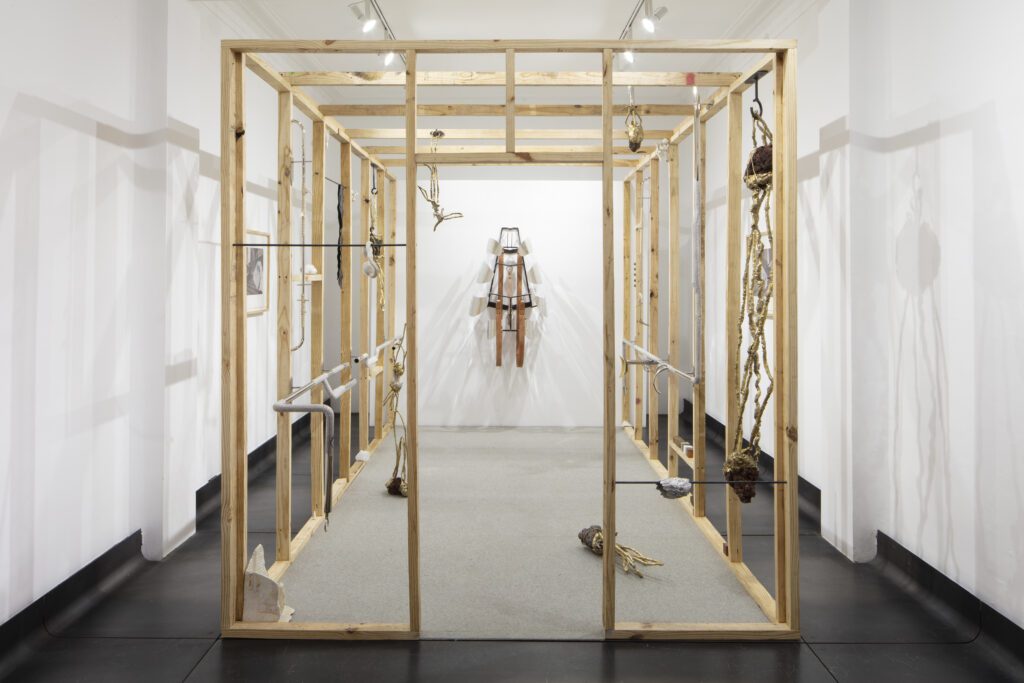
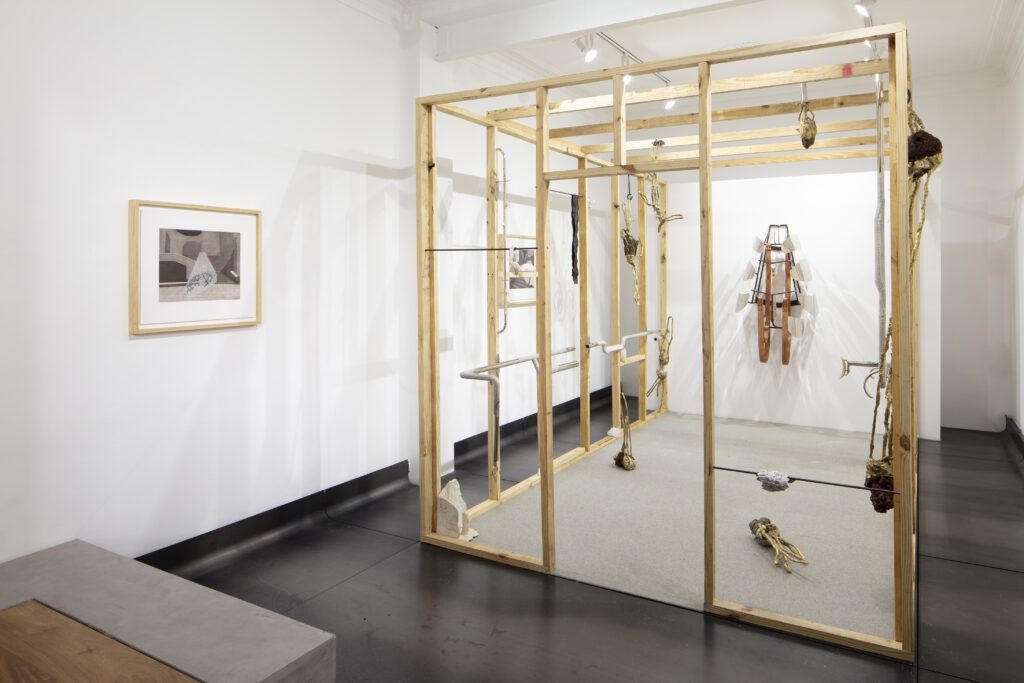
Innumerable Fires by Yeni Mao
Text by Laura Orozco
Innumerable Fires by Yeni Mao at Campeche gallery problematizes notions of danger and safety in relation to the architectures we inhabit: be that public or private spaces. On a physical and symbolic level, the first is usually conceptualized in relation to threat and the second to protection. In contrast, Mao rearticulates the various dynamic interactions that constitute both spaces and the bodies that occupy them.
The exhibition’s title alludes to the material interrelations of the human (body and soul) with the mineral and natural world, and can also be read in relation to the diverse forms fire (from the Latin focus) can take: as the center of domestic warmth, combustion when interacting with other materials, or the state of physical change that its presence implies. The latter is actually one of the main concerns present in the artist’s practice, seen as a passage from one state, concept or space to another. All the works on show are created by way of antagonistic processes and an unexpected mixture of materials, becoming one and many things all at the same time. Sustained in a semi-figurative and semi-abstract latency they allow for a constant reconfiguration. The wood structure can be seen as a membrane –a permeable border– that unites these spaces through division, and yet also encloses one place within another place (the gallery). Mao employs this structure, the cave or first shelter –which was presented in mythology as a transitional space for transcendental experiences and access to the underground– to imply protection over the fragility of human bodies, and as an “opulent box” where all our precious objects and memories are stored. Inspired by the artist’s own studio, this house keeps and displays various pieces that allude to human, animal, vegetable or mineral bodies that interact with each other through a translucent and minimal aesthetic.
Hanging on the wall and central to the exhibition is a large sculpture that seems to be a kind of body-hive-mother wearing armor. Its position allows us to read the intimate and familiar social interactions typical of domestic spaces or even religious temples, while evoking a futuristic aesthetic by way of two recognizable materials: steel and animal leather. Although both materials tend to be thought of in terms of great firmness and resistance, for Yeni Mao, these elements can also easily wear out, rust or break. In the collective imaginary both materials appear as tools that evoke a presence of control, whether due to the need for protection (armor), the illusory desire to apprehend uncertainty or, on the contrary, control as a gift in the face of trust between peers in BDSM practices (leather).
The artist’s process sits at the intersection of various historical and scientific references, as well as rational and meditative states; an encounter between the industrial and the artisanal, the machine and the hand. Making different worlds converge also translates onto the collapse of time, creating a kind of future past that redeploys elements from tribal traditions and countercultures to articulate a flexible and ever changing configuration of identities. The present cyberpunk and dystopian aesthetic comes from sci-fi films of the 80’s, where said cinematographic genre produced, through speculation and science, scenarios of upcoming social decay on the verge of destruction. Unlike industry representations, Yeni Mao’s works and installations pursue the creation of his own material and discursive present, far from the hegemonic narratives that tend to physically and discursively dominate lives and bodies. Both his condition of cultural and territorial displacement, as well as his dispossession of heteronormativity, have enriched and forced the artist to pursue a type of self-construction that explores his own history and current place in the world. Meaning, the artist’s idea of identity and culture is not formed through nationalist impositions and the territories demarcated by the State, but rather by a collection of experiences, social interactions and decisions carried out by desire. The references to specific cultures in the artist’s practice –including narratives and events from China and Mexico, indigenous traditions, obscure queer history, and many others– appear filtered by atypical readings and mechanisms of encounter. His work then, can be read as the production of microhistories that in turn negotiate and complete the larger History.
Culture is not merely an object, but what produces and affects said object in its collision with material and discursive reality. In this sense, culture is instituted in the words of Homi Bhabha as a space for confrontation and negotiation that allows the emergence of new zones of existence and translation between groups that strive to achieve a place of visibility and empowerment in the face of hegemonic logics of segregation and social erasure. For Bhabha, the present operates as a place of transit where space and time intersect to produce complex figures based on difference. A present time “beyond”, which is governed by disorientation, an incessant exploratory movement. The configuration of identities happens adrift, under the interaction and performativity of the members of society, their personal baggage and the global information that pressures them. This implies a major shift, through which peripheral societies are constituted by a power and a right to give meaning and value despite existing hegemonies and rampant capitalism, thus maintaining cultural difference without a scheme based on values or hierarchies.
Invention is thus presented as an alternative to the reconstruction of culture and history in Yeni Mao’s works, where he introduces elements from different origins within a dialogue of controlled disruption. The Skinwalker (fig. 36.4-7) pieces, rails of steel lined with snakeskin or “organisms” that lay between the industrial and the artisanal, act as tools or as a support for humans, evoking mythical and fearsome snakes, and representing entities that have the capacity to change shape at will thus awakening haptic desire and fear. The word “organism” comes from the idea of a system of living organs. In the 17th century, the separation of soul and body was a necessary component for the standardization of work as a pre-industrial method of production and for its scientific study (medicine). As such, the “system of living organs” left the “living” aside, to turn the organism into a mechanical, autonomous entity, where rationality, productivity and utility were the standard. In the encounter of man and nature, José Luis Barrios implies that language must yield to generate a possible dialogue that promotes a reconfiguration of the bond. The exchange then must happen “before language”, in the space of articulation of the murmur or scream, where emotion dictates beyond meaning. Art and poetry live in this category, as a language that is between the legible and the illegible. Such demarcations of the word oppose the foundational relationship of nature or animals with human beings and their possible links, as can be seen in the Skinwalker series.
In relation to human dynamics and sensitive apparatus, we could say that experiences of pain always evoke the tangible or rational, taking us to a place of wanting to ground ourselves. While on the contrary, moments of absolute joy bring us closer to experiences that transcend the senses, as if we escaped from our body for a moment. And yet various tribal, indigenous, and countercultures have shown us the opposite: that it is possible to experience events beyond mere experience through pain and letting go. Finding spirituality through events where we voluntarily surrender to danger or suffering implies taking agency, and in some cases even grants the other a kind of absolute trust over our body. Among these practices we can find tattoos and body modifications that various communities have practiced for thousands of years. These events, which occur in response to a certain hegemony of discourse as a desire for what is pristine and neat, provide an outlet and transcendental experiences beyond the norm. The presence of elements that allude to these spaces of resistance are a constant in Mao’s works, and in their occurrence they activate a tension between attraction and rejection. The change or metamorphosis of bodies is also present in the works You and me both (fig. 44.1-5), where two elements –rocks and bronze– meet through the process of melting and changing the state of matter: from solid to liquid and back again, but under radically different times and functions. The rock under its long geological times and its configuration based on rain and wind, and the bronze under productive temporalities such as technology at the service of humans and its creation via the mixing of minerals. For the artist, the production of these pieces operates alchemically, like an experimentation of the dialogue between chemistry, the material and the visual aspects of the elements.
Outside, behind the wooden structure, and hanging on the walls of the gallery are etchings titled Black Star (fig. 33.1-6)that depict wolves wandering like ghosts in the open field or public space. The buildings that operate as a background stage are actually of the Monumento a la Revolución in Mexico City, and the minimal architectural perspective is inspired by Mies van der Rohe’s collages. The superposition of these two references combine the function and use of State narratives through public architecture and sculpture, with van der Rohe’s desire to dissolve the boundaries between interior and exterior. The other side of the domestic wall implies a risk, an encounter with the unknown that entails danger. Wolves, under the human gaze, have been accompanied by mythologies that categorize them as strong, fast, predatory, and above all wild and fearsome. However, these animals gather in communities that accompany and care for each other, with violent actions always occurring in terms of survival. Their descendants, dogs, are the animals closest and dearest to humans. This ambiguity of categorization is taken as a condition in the work of Mao, where it is proposed that our relationships with others always constitutes a risk due to difference, but they also produce a coming together and the possibility of intimacy. For the artist, citing the phrase “Raised by wolves” implies the magical encounter of a human being who surrenders to animal life and therefore becomes subordinate to the social laws of the dominant society. Yeni Mao proposes relocating the category of home and world towards a language of the present, which is desirably contaminated and plural, thus promoting a real problematization of context.

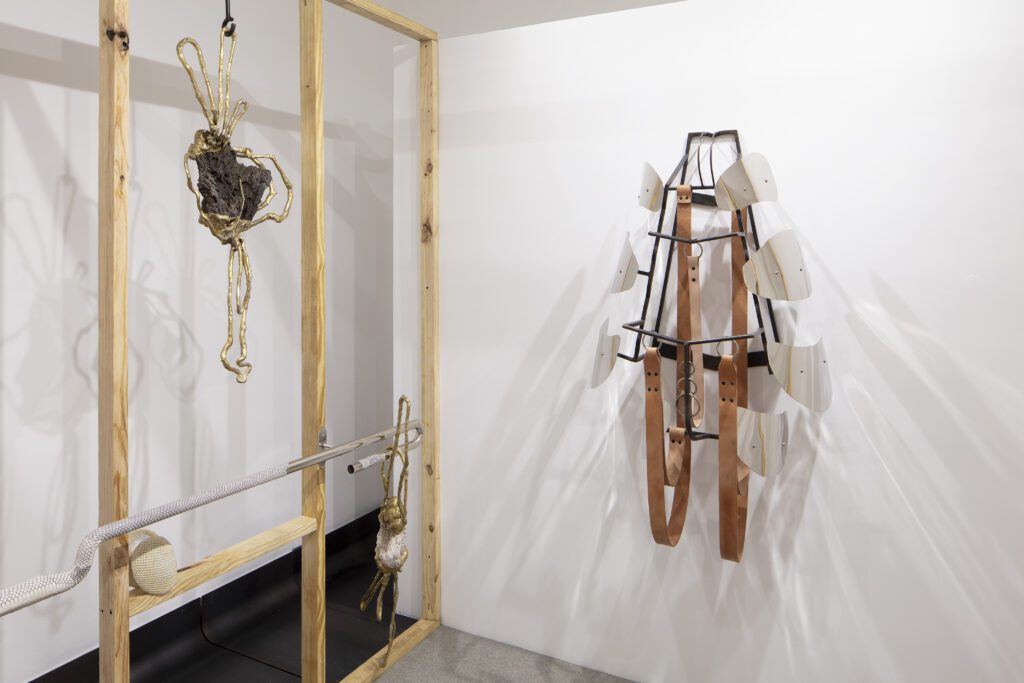
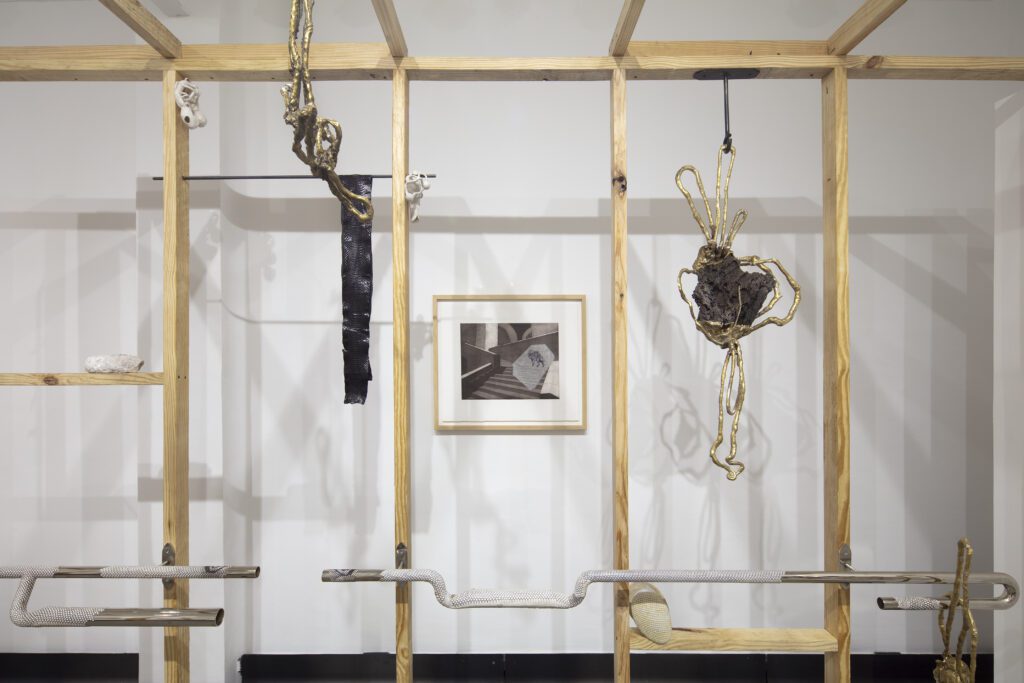
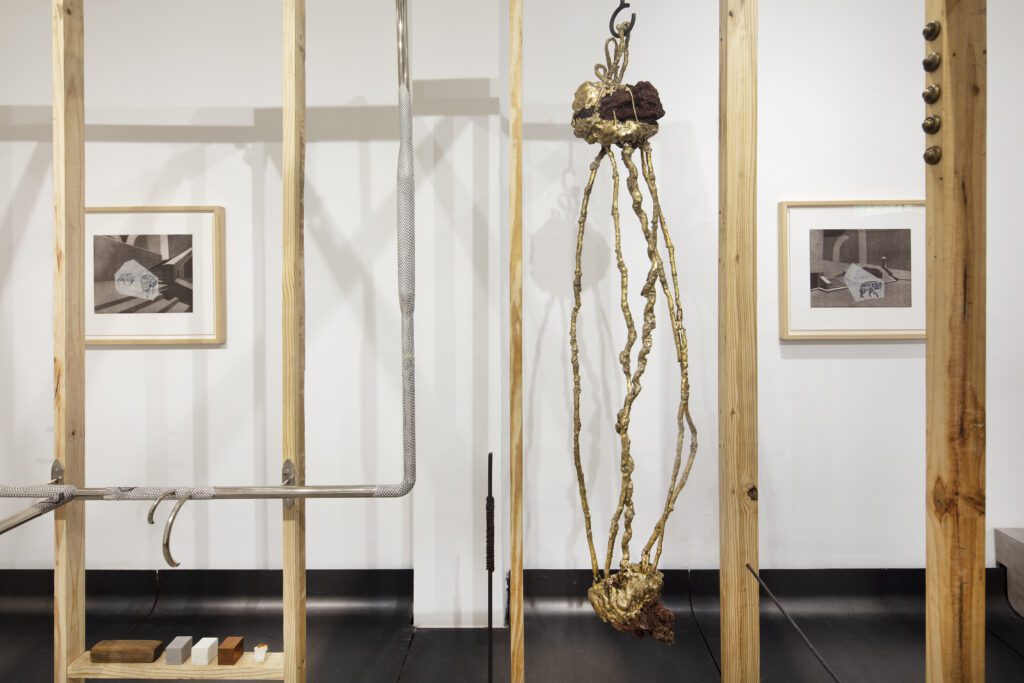
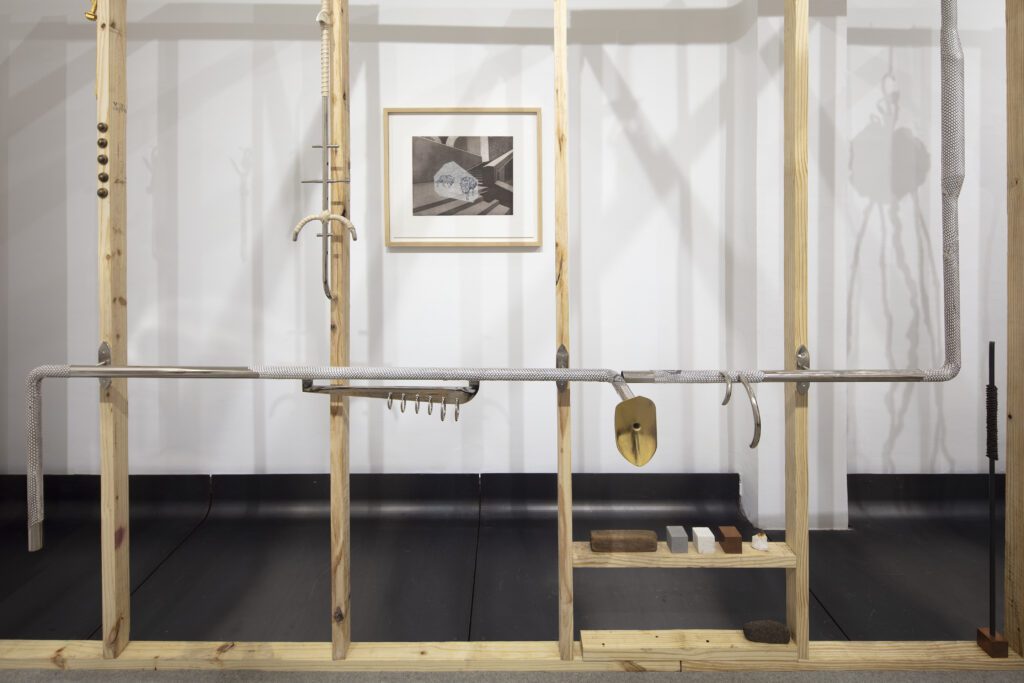
Innumerable Fires de Yeni Mao
Texto por Laura Orozco
La exposición Innumerable Fires de Yeni Mao en la galería Campeche problematiza las nociones de peligro y seguridad en relación a las arquitecturas que habitamos, el espacio público y el privado. A nivel físico y simbólico una suele pensarse en relación a la amenaza y la otra a la protección. En contraposición el artista realiza una rearticulación de las diversas interacciones dinámicas que constituyen a ambos sitios y a los cuerpos que los ocupan. El título de la exposición alude a las interrelaciones materiales de los humanos –incluyendo el cuerpo y alma– con el mundo mineral y natural, pero también puede leerse en relación a las múltiples formas que el fuego (del latin focus) puede tener: centro del calor doméstico, combustión bajo su interacción con otros materiales y al estado de cambio físico que implica su presencia. La última es de hecho una de las principales preocupaciones en la práctica del artista, el tránsito de un estado, concepto o espacio a otro.
Todas las obras presentes en esta exposición fueron creadas bajo procesos antagónicos y una mezcla de materiales inesperados, son por ende una y muchas cosas a la vez. Se sostienen en una latencia semifigurativa y semiabstracta que permite su reconfiguración constante. La presente estructura de madera puede considerarse una membrana –una frontera permeable– que une ambos espacios a partir de una división, y que a su vez encierra un lugar dentro de otro lugar (la galería). Mao utiliza esta estructura, cueva o primer refugio –presentada en la mitología como un espacio transicional para las experiencias trascendentales y acceso a lo subterráneo– para implicar la necesidad de protección sobre la fragilidad de nuestros cuerpos y como una “caja de opulencias” donde resguardamos nuestros más preciados objetos y recuerdos. Inspirada en el estudio del propio artista, esta casa exhibe y resguarda piezas que aluden a cuerpos humanos, animales, vegetales o minerales que interactúan entre sí a través de una estética traslúcida y mínima.
Montada sobre la pared y central a la muestra se encuentra una gran escultura que parece una especie de cuerpo-colmena-madre vistiendo una armadura. Su posición cardinal nos recuerda a formas sociales de organización espacial típicas de los sitios domésticos y religiosos, y a su vez, insinúan una estética futurista debido a la presencia de dos materiales reconocibles: el acero y la piel. Si bien, ambos materiales suelen pensarse como figuras de una gran firmeza y resistencia, para Yeni Mao, estos elementos también tienden a desgastarse, oxidarse o romperse. En el imaginario colectivo ambos materiales aparecen como herramientas que evocan la presencia de control, ya sea por la necesidad de protección (armadura), la necesidad ilusoria de aprehender la incertidumbre o por el contrario el control en tanto regalo de sujeción ante la confianza entre pares en prácticas de sadomasoquismo (cueros).
El proceso de creación del artista se encuentra en el cruce entre diversas referencias históricas y científicas, estados racionales y meditativos, metodologías industriales y artesanales, la presencia de la máquina y la mano. Dicha acción, de hacer converger distintos mundos se traduce en un colapso del tiempo, en un estado “pasado futuro”, que redistribuye elementos de culturas tribales y contraculturas para articular una configuración de identidades flexible y siempre cambiante. La estética ciberpunk y distópica proviene de películas sci-fi de los años ochenta, donde dicho género cinematográfico y literario producía por medio de la especulación y la ciencia, escenarios sociales futuros caóticos al borde de la destrucción. A diferencia de la representación por parte de dichas industrias, las obras e instalaciones de Yeni Mao persiguen la producción de un presente material y discursivo propio, alejado de las narrativas hegemónicas que tienden a dominar nuestras vidas y cuerpos.
Tanto su condición de desplazamiento cultural y territorial, así como su despojo de la heteronarmatividad, han forzado y motivado al artista a perseguir un tipo de autoconstrucción que permite explorar su propia historia en relación a su lugar actual en el mundo. En este entendido, la conformación identitaria y cultural del artista –lejos de formarse a través de las imposiciones nacionalistas y los territorios demarcados por el Estado–, se constituye a través de la recolección de experiencias, interacciones sociales y decisiones llevadas a cabo por el deseo. Las referencias sobre culturas específicas en su práctica –incluyendo narrativas y sucesos de Chinas y México, tradiciones indígenas, la oscura historia queer, entre muchas otras– aparecen filtradas por atípicos mecanismos de encuentro y lectura. Su trabajo, por ende, puede ser leído como la producción de microhistorias que a su vez negocian y completan la Historia.
La cultura no es un objeto, sino lo que produce e incide dicho objeto en tanto su colisión con la realidad material y discursiva. Lejos de la idea moderna de cultura (como arte, expresión del espíritu elevado de la tradición, lo colectivo nacional y étnico en la identidad y como expresión de la diferencia entre las formas bárbaras y la civilización) aquí se instituye en palabras de Homi Bhabha como un espacio de confrontación y negociación que permite la emergencia de nuevas zonas de existencia y traducción entre grupos que pugnan por alcanzar un lugar de visibilidad y empoderamiento frente a las lógicas hegemónicas de segregación y borramiento social. Para Bhabha, el presente opera como un espacio de tránsito donde el espacio y tiempo se cruzan para producir figuras complejas basadas en la diferencia. Un tiempo presente “más allá”, que se rige por la desorientación, un movimiento exploratorio incesante. La configuración de las culturas e identidades sucede a la deriva, bajo la interacción y performatividad de los miembros de la sociedad, sus bagajes personales, la información global que los apremia. Esto implica un viraje mayor, a partir del cual las sociedades periféricas sostienen el poder y derecho de dar significado y valor pese a las hegemonías existentes y al capitalismo rampante, de este modo mantienen la diferencia cultural sin un esquema impuesto de valores o jerarquías.
La invención se presenta como alternativa para la reconstrucción de la cultura y la Historia en el trabajo de Yeni Mao, donde introduce elementos de distintas procedencias bajo un diálogo de ruptura controlada. Las piezas fig 36.4-36.7 skinwalker, presentan rieles de acero forrados de cuero de serpiente o organismos que habitan entre lo industrial y lo artesanal. Las esculturas actúan como herramienta de apoyo para los humanos, evocan serpientes míticas y temibles, que representan entidades que poseen la capacidad de cambiar de forma a placer, en consecuencia despiertan simultáneamente el deseo y el miedo háptico. La palabra “organismo” proviene de la idea de un sistema de órganos vivos. En el siglo 17, la separación del alma y cuerpo fueron un componente necesario para la estandarización del cuerpo de trabajo y de su estudio científico (medicina). En tanto tal, el “sistema de órganos vivos” dejó lo “vivo” a un lado, para trasladar el entendimiento de la palabra “organismo” a estados mecánicos, entes autónomos, donde la racionalidad y la productividad o la utilidad eran el estándar. En el encuentro hombre – naturaleza, José Luis Barrios sugiere que el lenguaje debe ceder ante un posible diálogo para propiciar una reconfiguración vincular. El diálogo debe suceder en un antes del lenguaje, en aquel espacio de articulación del murmullo, el grito, donde la emoción dicta más allá de la significación. En esta categoría habita el arte y la poesía, en tanto lenguajes que se encuentran entre la figuración y la abstracción, entre lo legible y lo ilegible. Tal demarcación de la palabra opone la relación fundacional de la naturaleza o los animales con el ser humano como podemos ver en la serie skinwalker.
En relación a las dinámicas y mecanismos sensibles humanos, podríamos decir, que las experiencias de dolor nos repliegan siempre a lo tangible, a lo racional, a querer tocar y aferrarnos al suelo, y por el contrario, aquellos momentos de dicha absoluta nos acercan a experiencias trascendentes más allá de los sentidos, como si nos escapáramos durante un momento de nuestro cuerpo humano. Pero diversas culturas tribales, indígenas y contraculturas nos han demostrado lo opuesto: es posible experimentar eventos más allá de la vivencia cotidiana a partir del dolor y del soltar. Encontrar una espiritualidad por medio de eventos donde voluntariamente nos entregamos al peligro, al sufrimiento o al dolor, implica una toma de agencia y otorga al otro una especie de confianza absoluta sobre nuestro cuerpo. Entre estas prácticas podemos encontrar: los tatuajes y las modificaciones corporales que diversas comunidades han practicado durante miles de años. Estas acciones, que se presentan en contrarespuesta a cierta hegemonía que privilegia lo prístino y pulcro, otorgan una salida y vivencias trascendentes más allá de la norma. La presencia de elementos que aluden a estos espacios de resistencia son una constante en las obras de Mao, en su acontecer activan una tensión entre la atracción y el rechazo.
El cambio o la metamorfosis de los cuerpos está también presente en las obras fig 44.1 – 44.5 you and me both, en donde dos elementos –las rocas y el bronce– se encuentran a través del mismo proceso de fundido y de modificación del estado de la materia: de sólido a líquido y de nuevo a sólido, pero bajo tiempos y funciones radicalmente distintas: la roca bajo sus largos tiempos geológicos y su configuración a partir de la lluvia y el viento, el bronce bajo temporalidades productivas en tanto tecnología al servicio del humano y su concreción al mezclar minerales. Para el artista la producción de estas piezas opera como alquimia, como experimentación del diálogo entre la química, el material y el aspecto visual de los elementos.
Afuera, detrás de la estructura de madera montadas en las paredes de la galería se encuentran unas serigrafías bajo el título fig 43.1-43.6 black star, las cuales presentan lobos que deambulan como fantasmas en campo abierto, en el espacio público. El edificio, el escenario de fondo es el Monumento a la Revolución en la Ciudad de México, y la perspectiva arquitectónica minimalista está inspirada en los collages de Mies van der Rohe. La superposición de ambas referencias combina la función y uso de la arquitectura y esculturas públicas por parte del Estado, con el deseo de van der Rohe por disolver los límites entre interior y exterior. El otro lado del muro de lo doméstico, implica siempre un riesgo, un encuentro con lo desconocido que involucra peligro. Los lobos, bajo la mirada humana, han estado acompañados por mitologías que los categorizan como criaturas fuertes, veloces, depredadores, pero sobre todo salvajes y temibles. Sin embargo, estos animales se congregan en comunidades que se acompañan y cuidan mutuamente, la violencia sucede siempre en sentido de sobrevivencia. Sus descendientes, los perros, son los animales más cercanos y queridos por el humano.
Esta ambigüedad de categorización aparece como condicionante en la obra de Mao, en donde propone que nuestras relaciones con el otro siempre constituyen un riesgo por la diferencia, pero también producen una unión y la posibilidad de la intimidad. Para el artista citar la frase “Criado por lobos” implica el encuentro mágico de un ser humano que se entrega a la vida animal y por ende se resuelve en tanto subordinado de las leyes sociales de la sociedad dominante. Yeni Mao propone reubicar las categorías del hogar y mundo hacia un lenguaje del presente, que se construye en tanto deseablemente contaminado y plural, produciendo una verdadera problematización del contexto. 1 Gutiérrez, E. (2006). Cultura, organizaciones e intervención. Bogotá: Pontificia Universidad Javeriana.
2 Bhabha, H. (1994) El lugar de la cultura. Buenos Aires: Manantial.
3 Ibidem
4 Ibidem.
5 Federici, S. (2004). Calibán y la bruja. Mujeres, cuerpo y acumulación originaria. Madrid: Tráficante de sueños.
6 Ibidem.
7 Barrios, JL. (2016). Lengua herida y crítica del presente. Ciudad de México: Universidad Iberoamericana, Orbilibros
8 Ediciones, Revista Fractal.